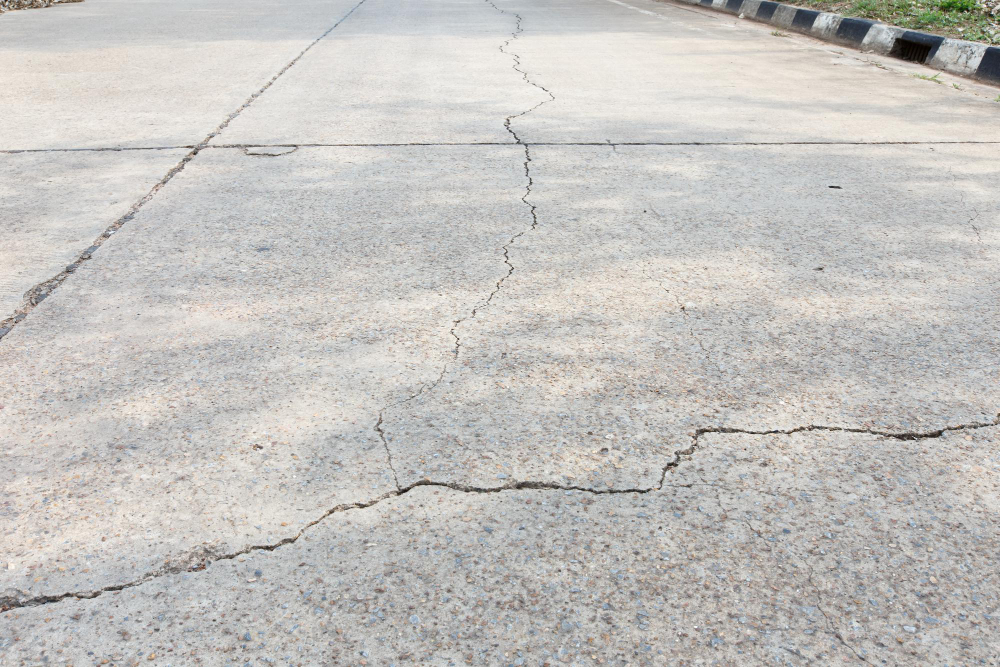
Cracks in concrete are a common headache for homeowners. Whether it’s your driveway, patio, or pool deck, once those cracks appear, they only tend to get worse — letting in water, dirt, and weeds, and creating uneven or unsafe surfaces. Thankfully, there are several methods on how to fix cracked concrete.
You don’t always need to replace your concrete. Depending on the severity of the damage, there are several ways to fix or cover cracked concrete — and one of the most effective and attractive solutions is using decorative concrete coatings.
Why Concrete Cracks
Before fixing the problem, it helps to understand why it happens in the first place.
Common causes include:
- Freeze-thaw cycles: Water seeps into pores, freezes, and expands, widening cracks.
- Heavy loads or traffic: Driveways and patios under constant stress can shift or fracture.
- Poor installation: Weak concrete mix or inadequate reinforcement can lead to early cracking.
- Soil movement or settling: Ground shifts under the slab can cause uneven tension and cracks.
Most concrete will eventually show some cracks — the key is how you repair and protect it to prevent them from worsening.
The Main Ways to Fix Cracked Concrete
There are three primary approaches homeowners often consider:
1. Crack Fillers and Patches
These are simple DIY products made from concrete or epoxy compounds. They’re great for small, hairline cracks, but over time they can flake or separate — especially in driveways and outdoor areas exposed to weather.
Pros: Affordable and quick.
Cons: Short-term fix; cracks often reappear.
2. Concrete Resurfacing
A resurfacer is a thin layer of cement-based mix applied over the old concrete. It can improve appearance and cover light imperfections. However, resurfacing doesn’t always hide deeper cracks and can chip or peel if the underlying concrete moves again.
Pros: Good cosmetic refresh.
Cons: Won’t hold up to shifting or wide cracks.
3. Concrete Coatings (The Long-Term Solution)
Concrete coatings are flexible, durable overlays designed to cover cracked concrete rather than simply patch it. Systems like Rubber Stone, Sierra Stone, and Vuba Stone adhere to your existing surface and create a seamless, attractive finish that resists future cracking.
Pros: Long-lasting, slip-resistant, customizable, and ideal for driveways, patios, and pool decks.
Cons: Professional installation required for best results.
Why Concrete Coatings Work So Well

Coating systems bond tightly to existing concrete and bridge small cracks, forming a flexible layer that moves with temperature changes and resists water intrusion.
They don’t just hide the damage — they strengthen and protect the concrete underneath.
For Driveways
Heavy vehicles and constant use can worsen driveway cracks. Coatings like Vuba Stone create a tough, decorative surface that handles weight and weather while improving curb appeal.
For Patios
Patios benefit from Sierra Stone’s natural stone look and texture. It masks cracks beautifully and creates a smooth, slip-resistant finish perfect for outdoor entertaining.
For Pool Decks
Pool decks face water, sun, and foot traffic. Rubber Stone is the ideal coating here — soft underfoot, flexible, and highly slip-resistant even when wet.
Comparing Rubber Stone, Sierra Stone, and Vuba Stone
| System | Best For | Key Benefits |
|---|---|---|
| Rubber Stone | Pool decks, patios | Soft, flexible, slip-resistant, hides cracks |
| Sierra Stone | Patios, walkways | Elegant natural-stone look, durable, low-maintenance |
| Vuba Stone | Driveways | Resin-bound strength, seamless finish, weather-resistant |
All three systems are installed by professionals who properly prep and repair cracks before coating — ensuring long-lasting results.
Step-by-Step: How to Cover Cracked Concrete with a Coating
- Inspect and clean the surface – Remove debris, oil, and loose concrete.
- Repair major cracks or holes – Fill deeper gaps to stabilize the slab.
- Prepare for adhesion – Light grinding or etching improves bonding.
- Apply the coating – Mix and spread the chosen system evenly across the surface.
- Seal and cure – Once dry, a protective sealant locks out moisture and extends lifespan.
Within just a few days, your cracked concrete surface can look brand new — no tear-out required.
When to Replace Instead of Repair
Coatings are ideal for most residential surfaces, but if your slab has major structural issues like heaving, sinking, or wide displacement, full replacement may be necessary.
A professional inspection ensures the right choice for your situation.
The Smart Way to Fix Cracked Concrete
Fixing cracked concrete isn’t just about aesthetics — it’s about preventing further damage and restoring safety and style. For most homeowners, a coating system is the perfect balance between cost, durability, and visual appeal.
If you want to cover cracks once and for all with a clean, custom finish, contact Concrete Coating Experts. Their team installs Rubber Stone, Sierra Stone, and Vuba Stone coatings designed to perform beautifully on driveways, patios, and pool decks throughout Western Washington.
📍 Visit concreteexpert.com or call (360) 502-1986 to schedule a free consultation.